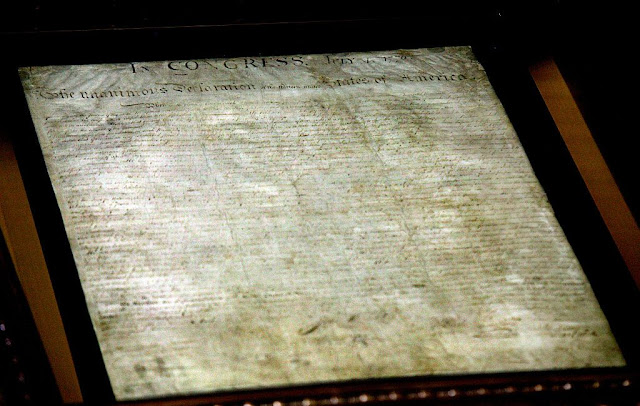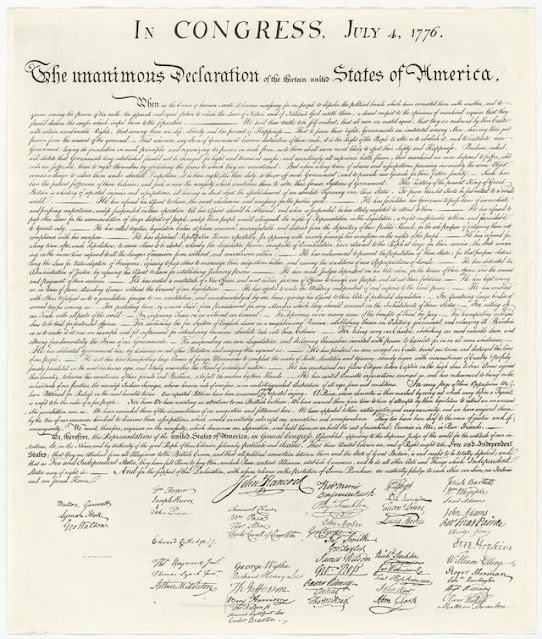---------oOo---------
From:
---------oOo---------
The Science of Saving the Declaration of Independence
How science helped—and harmed—efforts to preserve the U.S.'s founding documents.
Joe Pappalardo
July 4 2020
Popular Mechanics
The official declaration of America’s independence from Britain may be dated July 4, 1776, but the story of the Thomas Jefferson's hallowed document really begins two weeks later. On July 19, the Continental Congress ordered a scribe, Pennsylvania State House clerk Timothy Matlack, to write the words on a piece of parchment big enough for everyone to read—and with room for signatures.
Since then, the Declaration of Independence has had a fairly rough time. A forensic analysis of the document shows some rough handling, damaging displays, and even a mysterious handprint. Understanding why it looks the way that it does — much more faded and battered than the U.S. Constitution or The Bill of Rights — is a romp through the history of printing, preservation, and patriotism.
Old Tools, Faded Inks, Unfortunate Folds
The story starts with Matlack’s tools—a quill dipped in iron gall ink. That kind of ink was nothing special. It was cheap and commonly available at the time. “Because of its indelibility, it was the ink of choice for documentation from the Middle Ages to the twentieth century”—so says a non-profit website dedicated to iron gall ink.
Timothy Matlack, known for his excellent penmanship, wrote the original Declaration of Independence.
Its ingredients are stated in the name. Ground gall nuts, taken from an oak-like tree, were boiled to draw out tannic acid, which was mixed with iron sulfate scraped from nails. “The ingredients could also be mixed dry, which would produce ink the moment water was added to it,” the website continues. “This powder would make for a perfect traveling ink, created only as needed to avoid the opportunity for mold growth.” The scribe would etch letters that would gradually darken as oxygen works on the iron. Over time, that dark color mellows to a soft brown.
But the current custodians of the document—the National Archives—will tell you that almost no original ink remains on the Declaration of Independence. The document had no permanent home during the earliest days of the Revolutionary War, resulting in crude folding and rolling, causing some of the ink to flake off. As you can imagine, this rough treatment led to permanent damage.
“Evidence of previous folding and rolling is still visible on the Declaration,” says one National Archives analysis. “Two primary vertical fold lines run from top to bottom, and there are numerous horizontal fold lines especially in the lower part of the document.”
An example of the 1823 Stone engraving, created by printer William J. Stone using copperplates commissioned by then-Secretary of State John Quincy Adams.
Good Intentions, Terrible Results
Restorers with the best of intentions can still do plenty of harm, and early efforts to protect the Declaration damaged the document further.
While Secretary of State, future president John Quincy Adams commissioned full-sized copies of the Declaration to be made to limit the exposure of the original. The resulting copperplate is dated July 4, 1823.
It was a good idea, but the method of the day involved engraving the image on a copperplate. Step one of this involved pressing wet fabric against the ink to transfer an exact copy of the words onto the plate. This removed some ink and accounts for some of the faded look we see today, especially around the signatures.
Then things went from bad to worse. In 1841, the first exhibition hall in Washington D.C. opened in the Patent Office Building (now the National Portrait Gallery), and what better thing to display than the Declaration of Independence? It sounded like a smart idea, but over the course of 35 years on display, the document was exposed to damaging light that further faded what little ink remained.
Public officials lamented the damage, especially as photography came of age. The first photo of the Declaration, taken in 1883, charted the deterioration. By 1921, light was seen as a major threat to the historic document. Under the Library of Congress's stewardship, the Declaration and Constitution went on display with a sheet of yellow gelatin wedged between panes of glass.
Photography also revealed another piece of damage—a handprint at the lower left corner of the Declaration of Independence. Discovered in 1940, the handprint doesn't appear in a 1903 photo. No one knows how it got there, but conservators have decided not to remove it. Now the handprint remains as another piece of American lore.
The 1903 photograph by L. C. Handy contains critical evidence of the Declaration's legibility and condition in 1903 while in the custody of the State Department. At that date, there was no handprint evident nor the tide lines that are such a dominant feature of the document today.
This 1940 photograph shows the Declaration in its frame on exhibit at the Library of Congress. Note the presence of the handprint in the lower left corner and the tide lines in the center of the document that were not present in the 1903 L. C. Handy.
When Air Becomes an Enemy
Two men observing the Declaration of Independence, 1954.
A different preservation problem became clear by the 1940s. The humidity of sweltering Washington D.C. would soften the adhesive at the edges of the Declaration. When the humidity dropped, the parchment contracted and that tension caused the document to tear. Those tears only grew over time.
Exposure to air suddenly became public enemy number one. So, in 1951, the Declaration was sealed in an enclosure filled with humidified helium. The original Declaration of Independence stayed in this home, located in the Rotunda of the National Archives Building, for fifty years.
The Rotunda of the National Archives, which houses the Declaration of Independence, under renovation, December 2002.
In 2001, conservators noticed small surface cracks, crystals, and droplets forming on the glass. These signs of deterioration in time would cause the glass to become opaque. The Declaration and other founding documents needed a new home, re-encased in new airtight containers made of aluminum and titanium and filled with argon gas rather than helium. The relative humidity of the argon gas is at 40 percent, and the case remains continually at 67 degrees Fahrenheit.
Guns, Bells, and Bonfires
On July 3, 1776, John Adams wrote to his wife, Abigail, that the Continental Congress approved a resolution for independence.
“I am apt to believe that it will be celebrated by succeeding generations as the great anniversary festival,” he wrote. “It ought to be solemnized with pomp and parade, with shows, games, sports, guns, bells, bonfires and illuminations from one end of this continent to the other from this time forward forever more.”
Thanks to the work of preservationists—and sometimes despite their best efforts—those of us in the 21st century can see the fragile pages at the center of this celebration, shrouded in a cocoon of invisible argon gas.
One of 215 new U.S. citizens views the U.S.’s founding documents in Washington D.C., September 12, 2012.
---------oOo---------
I suppose that Nicolas Cage stealing the Declaration of Independence in National Treasure didn't do much good for it either . . .










No comments:
Post a Comment
Note: Only a member of this blog may post a comment.